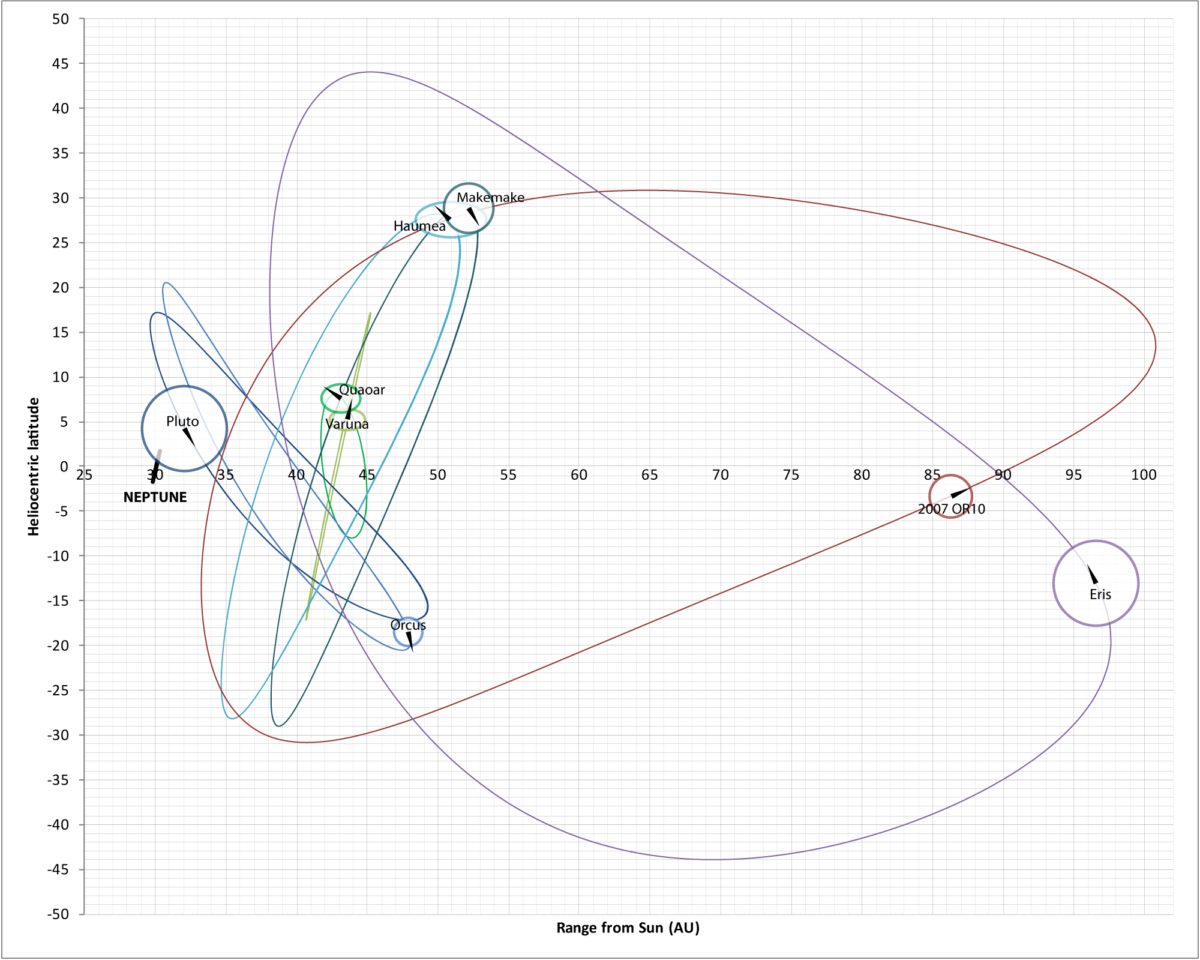Emily Lakdawalla • Feb 16, 2012
Where are the big Kuiper belt objects?
Earlier today I wrote a post about how to calculate the position of a body in space from its orbital elements. The particular reason I wanted this information now was because, for a project I'm working on, I'm trying to get a big-picture view of what's going on in trans-Neptunian space. Planets are in fairly circular orbits mostly confined to the ecliptic, so to understand their position in the solar system you really only need one piece of information: their average distance from the Sun. Earth is at 1 AU, Mars at about 1.5, Jupiter 5, and Saturn, Uranus, and Neptune at about 10, 20, and 30. Of course at different times they're at different positions in their orbits, but to a great extent you can predict the properties of a planet just by knowing how far from the Sun it is.
But Pluto and its neighbors generally have much more elliptical and inclined orbits, so average distance from the Sun just isn't enough information to let me form a mental picture of what's going on out there. I want to know: how far away are they now? How far and close do they get? And are they now going farther away or getting closer? Of the big eight objects that we know about (Pluto, Eris, Haumea, Makemake, Quaoar, Varuna, Orcus, and 2007 OR10), do any of them share similar orbits?
You can write down a table of basic orbital information -- semimajor axis, eccentricity, inclination -- but I can't make a picture of the solar system by staring at that table. I know that Pluto is relatively close and actually is sometimes closer to the Sun than Neptune, and I know that Eris is really far, but other than that, I've got no idea where these things are.
I have seriously spent day and night for almost a week ruminating about which orbital information is useful, and how to present it, and finally today I came up with a way that helps me begin to get a sense for what's going on out there. Here's the diagram I came up with; an explanation follows it. I think that this is just the start of what will be a very detailed diagram that gives a snapshot of the Kuiper belt, and I'd welcome input on it. I do ask that you not reproduce it without asking, as it's very much a work in progress and there's lots of things I want to do with it.
The X-axis is range from the Sun, in astronomical units (AU). The Y-axis is heliocentric latitude (the angular elevation of the object above the planet of the ecliptic). The closed loops show the path in range-latitude space that the eight biggest objects travel over time. The loops actually represent 600 years' worth of HORIZONS predictions of orbital positions (from 1600 to 2200), which loop repeatedly for the closer bodies but barely more than once for the most distant bodies.

The loops are not ellipses around the Sun; they show how near and how far the objects get over time, but they ignore longitude (that is, they ignore the distance traveled around the Sun over the course of a year).
Let's start at the left-hand side. On this particular diagram, planets, like Neptune, have nearly circular orbits (little change in range from the Sun) with low inclination. So Neptune's orbit makes a very short, thick, black slash near 30 AU. Kuiper belt objects usually have elliptical orbits with higher inclinations. More vertical loops indicate more circular orbits. Shorter loops indicate less-inclined orbits.
The most up-and-down and least-tall of the loops are for Quaoar and Varuna. These are classical Kuiper belt objects, with nearly circular orbits ranging from 40-45 AU. They're doing their own thing, with, apparently, little influence from Neptune.
All the other bodies on this diagram are in various orbital resonances with Neptune. Pluto and Orcus are "plutinos" in 2:3 orbital resonances, meaning that they orbit twice for every three Neptune years. One thing that I like about this diagram is that Pluto's "loop" doesn't intersect Neptune's, so it shows that although Pluto's and Neptune's orbits "overlap," with Pluto sometimes being a teeny bit closer to the Sun than Neptune, in fact the two bodies definitely never actually get near each other.
Makemake and Haumea have similar orbits and are in 6:11 and 7:12 resonances with Neptune, respectively. Although 2007 OR10 and Eris seem to be in a class all their own, with very long loops and high inclinations, they both do return to Neptune's neighborhood as Pluto, Orcus, Haumea, and Makemake do, and they are probably also in orbital resonances with Neptune (3:10 and 5:17, respectively).
The labeled circles/ellipses show the current positions of the eight objects as well as their relative sizes. The skinny black triangles point in the direction along the loop that the bodies are currently headed. I think that the aspect of this diagram that I'm least happy with is the size of the ellipses representing the positions of the bodies, because they obscure details of the orbital loops. And also because sizes are so much more uncertain than orbital data. I think that probably when I work on this some more I will replace those ellipses with dots, and then have callouts -- boxes of information for each of the bodies (magnitude, number, provisional designation, color, albedo, whatever people have managed to measure) that point to little dots with arrows representing the position and sense of motion of each body.
What do you guys think? Is this useful? Do you have any suggestions for improvements or additions?
The Time is Now.
As a Planetary Defender, you’re part of our mission to decrease the risk of Earth being hit by an asteroid or comet.
Donate Today

 Explore Worlds
Explore Worlds Find Life
Find Life Defend Earth
Defend Earth

